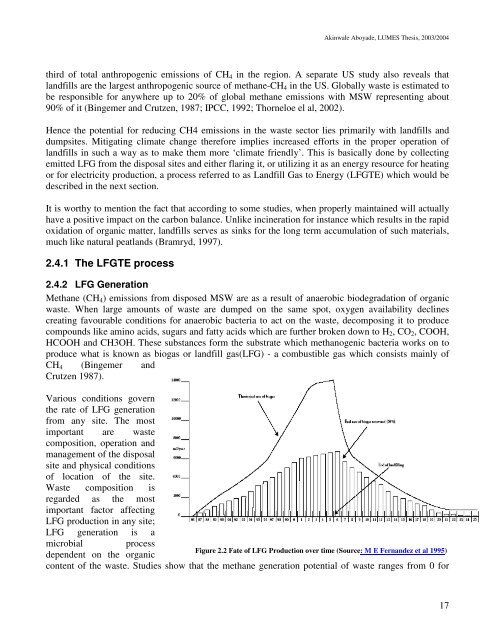Wale Aboyade's thesis - lumes
Wale Aboyade's thesis - lumes
Wale Aboyade's thesis - lumes
Create successful ePaper yourself
Turn your PDF publications into a flip-book with our unique Google optimized e-Paper software.
Akinwale Aboyade, LUMES Thesis, 2003/2004<br />
third of total anthropogenic emissions of CH 4 in the region. A separate US study also reveals that<br />
landfills are the largest anthropogenic source of methane-CH 4 in the US. Globally waste is estimated to<br />
be responsible for anywhere up to 20% of global methane emissions with MSW representing about<br />
90% of it (Bingemer and Crutzen, 1987; IPCC, 1992; Thorneloe el al, 2002).<br />
Hence the potential for reducing CH4 emissions in the waste sector lies primarily with landfills and<br />
dumpsites. Mitigating climate change therefore implies increased efforts in the proper operation of<br />
landfills in such a way as to make them more ‘climate friendly’. This is basically done by collecting<br />
emitted LFG from the disposal sites and either flaring it, or utilizing it as an energy resource for heating<br />
or for electricity production, a process referred to as Landfill Gas to Energy (LFGTE) which would be<br />
described in the next section.<br />
It is worthy to mention the fact that according to some studies, when properly maintained will actually<br />
have a positive impact on the carbon balance. Unlike incineration for instance which results in the rapid<br />
oxidation of organic matter, landfills serves as sinks for the long term accumulation of such materials,<br />
much like natural peatlands (Bramryd, 1997).<br />
2.4.1 The LFGTE process<br />
2.4.2 LFG Generation<br />
Methane (CH 4 ) emissions from disposed MSW are as a result of anaerobic biodegradation of organic<br />
waste. When large amounts of waste are dumped on the same spot, oxygen availability declines<br />
creating favourable conditions for anaerobic bacteria to act on the waste, decomposing it to produce<br />
compounds like amino acids, sugars and fatty acids which are further broken down to H 2 , CO 2 , COOH,<br />
HCOOH and CH3OH. These substances form the substrate which methanogenic bacteria works on to<br />
produce what is known as biogas or landfill gas(LFG) - a combustible gas which consists mainly of<br />
CH 4 (Bingemer and<br />
Crutzen 1987).<br />
Various conditions govern<br />
the rate of LFG generation<br />
from any site. The most<br />
important are waste<br />
composition, operation and<br />
management of the disposal<br />
site and physical conditions<br />
of location of the site.<br />
Waste composition is<br />
regarded as the most<br />
important factor affecting<br />
LFG production in any site;<br />
LFG generation is a<br />
microbial process<br />
Figure 2.2 Fate of LFG Production over time (Source: M E Fernandez et al 1995)<br />
dependent on the organic<br />
content of the waste. Studies show that the methane generation potential of waste ranges from 0 for<br />
17

















